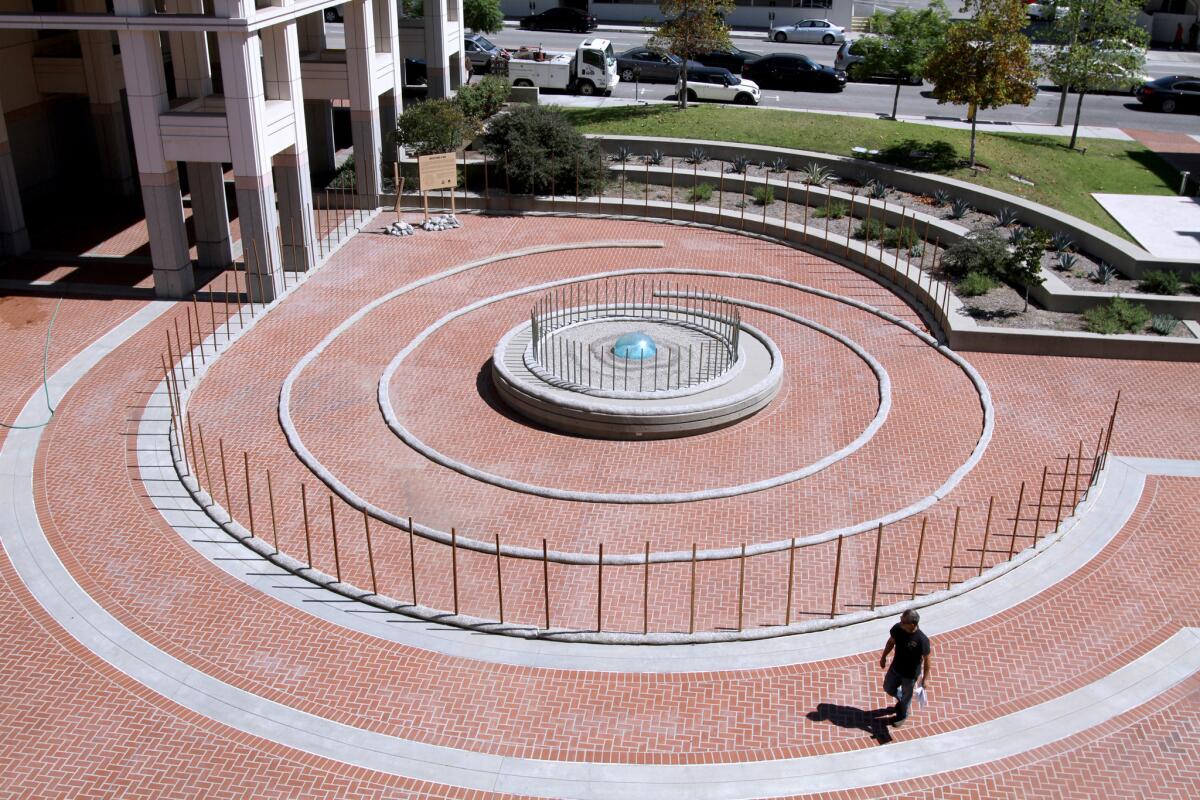Local residents, artists and art advocates meet for panel discussion on public art in Glendale

A new art installation called “Water Finds A Way” has been placed at Perkins Plaza near city hall, in Glendale, shown on Friday, September 18, 2015.
In the ongoing search for Glendale’s identity, 50 local residents, artists and art advocates listened to a panel of three art planners discuss how Glendale can showcase more public art.
The Thursday evening talk, hosted by the Associates of the Brand Library and Art Center and the Glendale Library Arts & Culture Commission, featured the panelists offering their ideas to expand public art displays and events within the Jewel City.
The panel included Glendale resident Joy Feuer, who has helped oversee the installation of four recent public art projects, including “Water Finds A Way” — a labyrinth exhibit adjacent to City Hall.
Some attendees questioned how Glendale could become a public arts destination when, for so long, it has held its reputation as a quiet suburb.
“Glendale is often passed through on the way to other things,” local resident Joann Hedge said.
Others spoke of Glendale as a hub for shopping and auto dealers with the Glendale Galleria, Americana at Brand and Brand Boulevard of Cars. It’s also known for its historic gems such as the Brand Library and Alex Theatre.
But for public art, Ara Oshagan, an artist and Glendale Arts & Culture Commissioner, said, “We have literally, very little.”
Even so, the city has access to an Urban Art Fund amounting to about $3 million, Oshagan said, a result of a 2010 city ordinance requiring developers to contribute 1% of their projects’ values to the fund.
With money to work with, fellow commissioner Teri Deaver said the group wants to create an urban art master plan and find answers to some questions.
“Who is Glendale? What is our identity? What is it that we want to say?” she said.
“I have a personal interest in developing the city as a destination,” Feuer said.
For her art projects, so far, she’s selected sites that are historic, symbolic and come with high traffic. She recently brought in Yarn Bombing Los Angeles to decorate the Alex Theatre’s 20-foot columns when, coincidentally, the Alex marked its 90th anniversary.
She chose Glendale Central Park to install a sculpture titled “The Glendale Picnic,” where people can sit or rest on the piece.
“You want people to become part of the art,” she said. “You can definitely touch this, sit in it, experience it.”
When Arlene Vidor, president of Brand Associates, asked Feuer if she is getting support from the city in her effort to display public works, Feuer said employees were quick to support her with the labyrinth project located near the city’s municipal services building.
Overall, however, she said support for public art in Glendale is “not coming from the top down.”
“For every groundbreaking someone’s at, they should be at our event,” she said of city officials. “If we want to be a destination for the arts, then every single person who works for the city needs to buy into it.”
Fellow Glendale resident Tamara O’Connor agreed.
“We just don’t have the support for public art,” she said.
O’Connor’s friend Debra Thompson, an art history professor at Glendale Community College and board member for Brand Associates, pointed out that not one council member attended the discussion Thursday night.
Feuer also said local artists need to participate more in the effort rather than complaining about the lack of art in Glendale.
And Vidor pointed to the strong presence in Glendale by officials and residents alike for historic preservation. She suggested the same needed to be achieved for public art.
“We do all need to be advocates. We do need to become politically involved,” Vidor said.
Even with city support, Robert Crouch, a panelist and interim executive director of the Pasadena Arts Council, said the effort can be done in small steps.
“You always need some sort of grass-roots support. Look at things that build civic pride,” Crouch said.
Art commissioner Arlette DerHovanessian said the quiet suburb of Glendale is beginning to wake up.
“I think our bedroom community has just walked into the hallway,” she said.
--
Kelly Corrigan, kelly.corrigan@latimes.com
Twitter: @kellymcorrigan